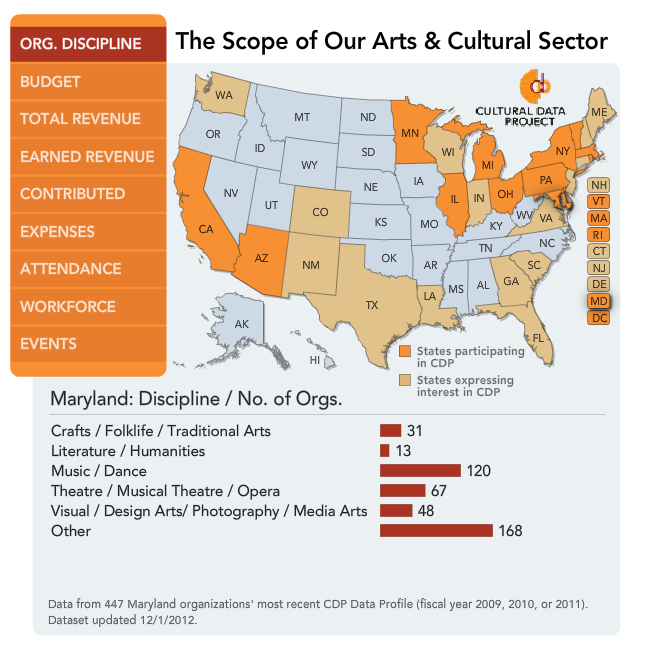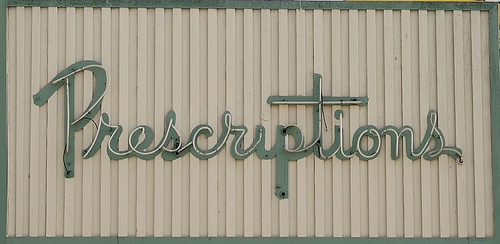Big data isn’t something that’s just being covered breathlessly by the likes of Forbes and Fast Company; arts and culture organizations and nonprofits are generating, collecting and sifting through their own data and collaborating to make sense of it all. Initiatives like the Cultural Data Project (CDP) and the National Arts Index have been collecting and sharing data since 2004 and 1998 respectively (check out Baltimore’s Local Arts Index).
The CDP is an online tool which allows arts and cultural organizations to report, review and analyze organizational, programmatic and financial data. Originally developed through a collaboration of Pennsylvania funders, the project expanded to other states beginning in 2007 with Maryland. It now includes 12 states and the District of Columbia. Locally, Maryland State Arts Council is a member of the Maryland CDP Task Force and requires many grantseekers to complete a CDP organizational profile. More than 14,000 arts and cultural organizations have completed a profile, including 447 Maryland organizations (as of December 1st, 2012).
This data collection process results in reliable longitudinal data that is useful to researchers and advocates, as well as grant makers and the participant organizations. Participants can run and download reports that compare their activity from year to year, as well as comparisons against data aggregated by other participating organizations on the basis of organization type, geography and budget size.
While it has been run and organized by The Pew Charitable Trusts for the past eight years, the project is currently in transition and will begin operating as an independent nonprofit as of April 1st, 2013. In addition, it announced a collaboration with the arts and business schools at Southern Methodist University (SMU) and other partners to create a National Center for Arts Research (NCAR) at SMU. Together, these organizations look to be a nationwide resource on arts attendance and patronage, the impact of the arts in our communities and the financial trends and health of arts nonprofits. This new center will build upon the comparison reports currently available via the CDP:
NCAR will maintain a website with an interactive “dashboard,” created in partnership with IBM, which will be accessible to arts organizations nationwide. Arts leaders will be able to enter information about their organizations and see how they compare to the highest performance standards for similar organizations in areas such as community engagement, earned and contributed revenue, and balance sheet health.
The current shortcomings and the future potential of the CDP have been outlined in a great article by Talia Gibas and Amanda Keil. Issues such as this were much on my mind as I attended the Greater Baltimore Cultural Alliance (GBCA)’s gathering of cultural data collectors. While the original invite and some of the presentations focused on mapping data, a broader conversation also took place about the challenges local arts nonprofits face when collecting and analyzing data. I was actually delighted that representatives of the Baltimore tech community (Sharon Paley of the Greater Baltimore Technology Council and Kate Bladow, coordinator of the Tech and Social Change meetup) were attending and a partnership with GBTC has resulted.
There was some discussion that an ongoing group would meet around these issues and, should that come to fruition, I look forward to the opportunity to participate further and meet more individuals involved in the arts and nonprofits who are looking for data-driven answers about the impact of their work. One of my major takeaways from this session, however, was that my consideration of data shouldn’t be limited to metrics of impact, but also the power of data to describe our community. I look forward to highlighting some of this work already ongoing in Baltimore in future columns.



For Art lovers and for people who really want to make a difference in the world.Inspirational and at the same time heart-touching film.
“Art From the Streets” is an award-winning, feature-length documentary about an unique art program for the homeless. Run entirely by volunteers, this program provides art supplies and a space for homeless people to create art. During a weekend every November, the art is sold, and the proceeds go to the artist. This documentary follows five of the artists over the course of a year. Viewers will visit homeless camps, learn the daily struggles of street life, and witness the strengths of the human character. Through their participation in this remarkable program, we see first hand how the lives are changed for all involved.
www (dot) cultureunplugged (dot) com/play/10989
[…] Big Data Meets Art | ChangingMedia […]